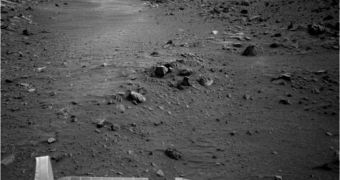On Thursday, the Spirit Mars rover took its first drive since April 8th, when it started exhibiting “memory problems.” Confronted with bouts of amnesia, as in problems with its flash drive, the tiny robot was unresponsive to commands for a while, and rebooted its onboard computers a few times. On April 23rd, mission controllers and engineers at the Jet Propulsion Laboratory, in Pasadena, California, considered it was OK to try and move the explorer, so they created the command lines, and uploaded them into Spirit's computers. It drove about 1.7 meters (5.6 feet) towards its destination, which is still a good 150 meters (about 500 feet) away.
“We expect we will see more of the amnesia events, and we want to learn more about them when we do. We decided not to wait until finishing the investigations before trying to drive again. Given Spirit's limited power and the desire to make progress toward destinations to the south, there would be risks associated with not driving,” JPL expert Sharon Laubach, the chief of the rover sequencing team, explained in a press release on the NASA website. She is in charge with developing and double-checking the daily set of commands that go to the rovers on Mars.
Originally scheduled to be operate on the Red Planet for roughly three months, the two twin robots of the Mars Exploration Rovers (MER) mission, Spirit and Opportunity, still scout the sands and stones of the planet more than five years afterwards. They have both exceeded their mission times by more than 20 times, and have saved NASA the expense of having to create and deploy new explorers. Readings from the robots, combined with those from the Mars Reconnaissance Orbiter and the Mars Odyssey, make up for a very powerful observation system on our neighboring planet.
On several occasions, the JPL crew used meteorological data from the MRO to plan for the rovers' moves. The orbiter is capable of taking pictures at a resolution that is similar to that of the best Earth-observing satellites in our planet's orbit. This wonderful achievement was completed in 2008 by the successful deployment of the Phoenix Mars Lander, which managed to successfully conclude its mission, finally demonstrating beyond a reasonable doubt that ice water still existed on the Red Planet.
At this point, both rovers show some signs of aging. For example, Spirit has been driving backwards for quite some time now, on account of the fact that one of its front wheels got stuck at one point. Some of Opportunity's instruments have failed mechanically, but the team of engineers in charge of operating them says that it's gained a very valuable expertise in coping with planetary exploration robots, which will come very in handy during future missions, where adaptation is the key.

 14 DAY TRIAL //
14 DAY TRIAL //